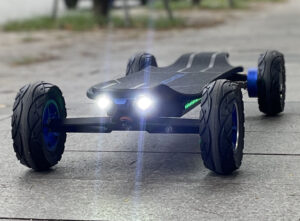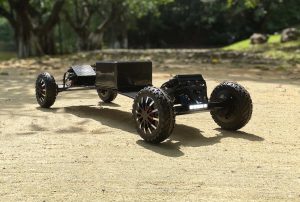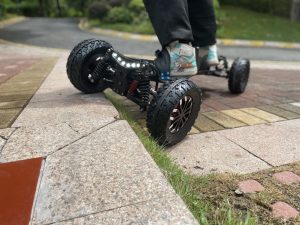Introduction
Riding on a board with four wheels and propelling oneself off the ground with one’s feet is probably the most well-known aspect of skateboarding. Since skateboarding allowed surfers to replicate the sense of riding waves on land when ocean conditions weren’t ideal, it was first closely linked to surf culture in California in the 1950s. Skateboarding gained popularity in the 1960s and 1970s when the first competitions were held and well-known brands introduced new goods.
Today, skating offers benefits to people of all ages, both physically and mentally, whether they wish to try doing tricks in skateparks or just cruise around town for enjoyable transportation.

Benefits of Starting Skateboarding at a Young Age
Early participation in skateboarding can have many positive physical and psychological effects. In terms of physical development, general motor skills, and coordination are enhanced when skateboarding is learned at a young age. Skaters are always forced to keep their balance while moving simultaneously. It is believed that this balance training greatly enhances brain function in the cerebellum. Young skaters develop extraordinarily improved proprioception—the unconsciously felt awareness of one’s body position—through consistent practice. They also have faster reflexes and increased agility, which helps them skillfully adjust to shifting terrain.
Skateboarding encourages perseverance in children’s cognitive development since it teaches them skills via practice. The act of thinking through motions while executing maneuvers can also help them become more focused and attentive. Early exposure to this brain-stimulating physical activity may have positive effects that extend beyond academic achievement. When kids start skateboarding early, they can constructively learn from their mistakes. They get back up after falling and attempt again. They develop resilience as a result, which helps them as they mature.
Physical Development Needed for Skateboarding
It takes specific physical characteristics to enjoy skating successfully and securely. Riders must be able to maintain their center of gravity while rolling and twisting on the board, therefore having strong balance and coordination is essential. Before moving on to more complex movements, it’s critical to develop a steady, balanced posture. Since skating requires using the legs for propulsion, braking, squatting, and kicking/jumping the board about, strengthening your legs is also essential. An avid skater’s legs and ankle muscles develop tremendous strength over time.
However, adolescent bodies may be more vulnerable to harm than older, more physically mature people because skating does have an inherent risk of injury from crashes. The physical demands of skating must also be taken into account, even though wearing the right safety equipment can greatly reduce the danger of damage. It is best to start skating at an age when children have had time to develop their leg muscle foundation and adjust their coordination before taking on more difficult tasks.

Mental Development Needed for Skateboarding
For safe skateboarding, a few mental skills are required. Skateboarding demands a high level of focus and concentration due to its frequent balancing acts and trick execution. Young skaters must have the ability to block out outside noise and focus solely on their boarding maneuvers. Acquiring abilities is another method that gradually increases self-assurance. Confidence in one’s skills and willingness to take chances grows when one accomplishes little objectives and learns new tricks. Additionally priceless are sound judgment and decision-making skills. Skaters need to be able to analyze terrain, assess risks, and make snap decisions about how to safely manage various scenarios. Although having fun is the main goal, skating does include some risks that need to be carefully considered. Naturally, young toddlers still have a lot to learn about these cognitive abilities. Beginning in pre-adolescence enables more mature decision-making, mental toughness in the face of difficulties, and improved comprehension of risk relative to skill level. This increases the likelihood that safe skateboarding will pay off in the long run.
Safety Tips for Beginning Skaters
For any new skater, but particularly important for growing bodies, certain safety precautions should always be followed. Full protective gear is a must at all times, including a helmet, pads for elbows and knees, and sturdy shoes. Young children especially must wear a helmet, as even mild head injuries could have serious consequences at their stage of development. Learning control on flat ground before stunts is wise – start with just cruising and braking. Young skaters also need constant supervision by an adult until they demonstrate safe practices. Even then, parents should skate alongside children to monitor for dangers. Finally, skating location is key – choose smooth, dry surfaces away from traffic or other hazards. Skateparks are excellent once basic skills are achieved since proper equipment is required and risks are controlled. Following these basic tips helps set up new skaters, especially the youngest, for a fun experience with minimal chances of injury.
Starting Age Recommendations
So at what point are kids developmentally ready to start skateboarding? Expert opinions and studies provide some guidance. Many professional skateboard instructors and organizations recommend around age 7 as the earliest starting point. By this age, motor skills are moderately developed and kids can understand basic safety principles if supervised. However, most experts stress it’s better to wait until around ages 8-10 to start regularly skating. At this stage, physical coordination is higher and children have a stronger sense of risk assessment. Studies examining injury rates found that skateboarding before age 9 significantly increases risk compared to later ages when bones and cognition have further matured. Nonetheless, balance bikes or skating in very supervised environments may still offer benefits even younger. Overall, between 8-12 years old is considered the best general age range for most children to feel comfortable on a board and minimize injury risk, provided they receive proper gear, learn basics slowly, and are continually coached on safety.

Conclusion
In closing, while skateboarding can offer fun and exercise for all ages, certain developmental milestones are important to consider when first starting. Allowing young bodies adequate time to build coordination, leg strength, focus, and understanding of risk helps maximize the enjoyment of this activity safely over the long run. Most experts agree between 8-12 years old provides a good balance where skills have progressed enough while growth plates are less prone to injury. Following safety protocols like protective gear, basic skill learning, adult guidance, and suitable locations also goes far in preventing unintended harm. With physical and mental readiness, instructive progression, and safety top of their minds, many children can experience the lifelong benefits that skateboarding has to offer when starting at an appropriate early age. Always prioritizing well–being over unnecessary risks sets the stage for developing confident and careful skaters of all skill levels.




